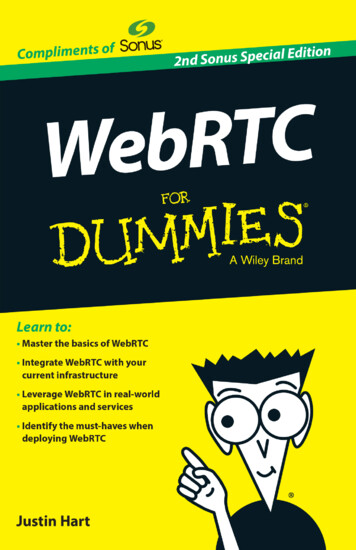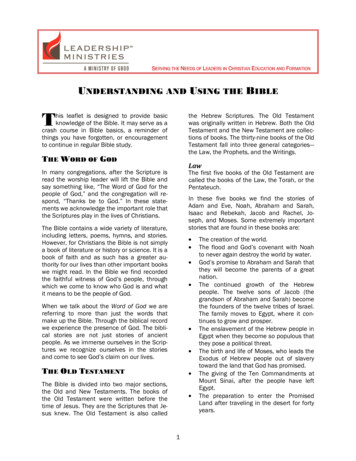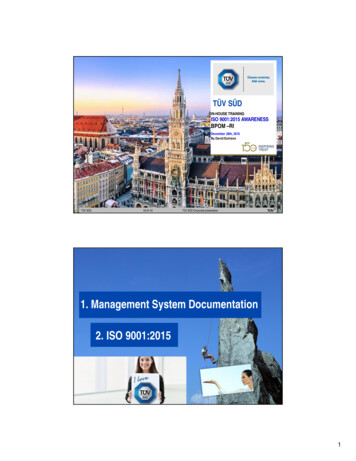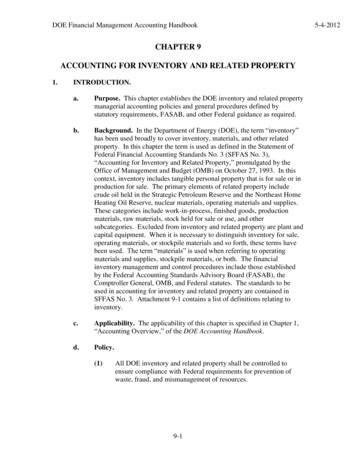
Transcription
These materials are 2015 John Wiley & Sons, Inc. Any dissemination, distribution, or unauthorized use is strictly prohibited.
WebRTC2nd Sonus Special EditionBy Justin HartThese materials are 2015 John Wiley & Sons, Inc. Any dissemination, distribution, or unauthorized use is strictly prohibited.
WebRTC For Dummies , 2nd Sonus Special EditionPublished byJohn Wiley & Sons, Inc.111 River St.Hoboken, NJ 07030‐5774www.wiley.comCopyright 2015 by John Wiley & Sons, Inc.No part of this publication may be reproduced, stored in a retrieval system or transmitted in anyform or by any means, electronic, mechanical, photocopying, recording, scanning or otherwise,except as permitted under Sections 107 or 108 of the 1976 United States Copyright Act, without theprior written permission of the Publisher. Requests to the Publisher for permission should beaddressed to the Permissions Department, John Wiley & Sons, Inc., 111 River Street, Hoboken, NJ07030, (201) 748‐6011, fax (201) 748‐6008, or online at http://www.wiley.com/go/permissions.Trademarks: Wiley, For Dummies, the Dummies Man logo, The Dummies Way, Dummies.com,Making Everything Easier, and related trade dress are trademarks or registered trademarks of JohnWiley & Sons, Inc. and/or its affiliates in the United States and other countries, and may not be usedwithout written permission. Sonus and the Sonus logo are registered trademarks of Sonus. All othertrademarks are the property of their respective owners. John Wiley & Sons, Inc., is not associatedwith any product or vendor mentioned in this book.LIMIT OF LIABILITY/DISCLAIMER OF WARRANTY: THE PUBLISHER AND THE AUTHOR MAKENO REPRESENTATIONS OR WARRANTIES WITH RESPECT TO THE ACCURACY ORCOMPLETENESS OF THE CONTENTS OF THIS WORK AND SPECIFICALLY DISCLAIM ALLWARRANTIES, INCLUDING WITHOUT LIMITATION WARRANTIES OF FITNESS FOR APARTICULAR PURPOSE. NO WARRANTY MAY BE CREATED OR EXTENDED BY SALES ORPROMOTIONAL MATERIALS. THE ADVICE AND STRATEGIES CONTAINED HEREIN MAY NOT BESUITABLE FOR EVERY SITUATION. THIS WORK IS SOLD WITH THE UNDERSTANDING THATTHE PUBLISHER IS NOT ENGAGED IN RENDERING LEGAL, ACCOUNTING, OR OTHERPROFESSIONAL SERVICES. IF PROFESSIONAL ASSISTANCE IS REQUIRED, THE SERVICES OF ACOMPETENT PROFESSIONAL PERSON SHOULD BE SOUGHT. NEITHER THE PUBLISHER NORTHE AUTHOR SHALL BE LIABLE FOR DAMAGES ARISING HEREFROM. THE FACT THAT ANORGANIZATION OR WEBSITE IS REFERRED TO IN THIS WORK AS A CITATION AND/OR APOTENTIAL SOURCE OF FURTHER INFORMATION DOES NOT MEAN THAT THE AUTHOR ORTHE PUBLISHER ENDORSES THE INFORMATION THE ORGANIZATION OR WEBSITE MAYPROVIDE OR RECOMMENDATIONS IT MAY MAKE. FURTHER, READERS SHOULD BE AWARETHAT INTERNET WEBSITES LISTED IN THIS WORK MAY HAVE CHANGED OR DISAPPEAREDBETWEEN WHEN THIS WORK WAS WRITTEN AND WHEN IT IS READ.For general information on our other products and services, or how to create a custom ForDummies book for your business or organization, please contact our Business DevelopmentDepartment in the U.S. at 877‐409‐4177, contact info@dummies.biz, or visitwww.wiley.com/go/custompub. For information about licensing the For Dummies brand forproducts or services, contact BrandedRights&Licenses@Wiley.com.ISBN: 978‐1‐119‐09878‐2 (pbk); ISBN: 978‐1‐119‐09885‐0 (ebk)Manufactured in the United States of America10 9 8 7 6 5 4 3 2 1Publisher’s AcknowledgmentsSome of the people who helped bring this book to market include the following:Project Editor: Carrie A. JohnsonEditorial Manager: Rev MengleAcquisitions Editor: Katie MohrBusiness Development Representative:Sue BlessingProduction Editor: Vinitha VikramanThese materials are 2015 John Wiley & Sons, Inc. Any dissemination, distribution, or unauthorized use is strictly prohibited.
Table of ContentsForeword. . . . . . . . . . . . . . . . . . . . . . . . . . . . . . . . . . . . . . . . . vIntroduction . . . . . . . . . . . . . . . . . . . . . . . . . . . . . . . . . . . . . . 1About This Book. 1Icons Used In This Book. 2Chapter 1: Getting Acquainted with WebRTC . . . . . . . . . 3Who Supports WebRTC Today?. 4How Does WebRTC Work?. 5Why is WebRTC Important?. 6Understanding the Elements that Make Up WebRTC. 7Browsers. 7Web browser APIs. 8Web servers. 9Codecs. 9Web applications. 9Gateways. 10Session Border Controller. 10Understanding the Data Channel. 12Chapter 2: Integrating WebRTC intoOther Networks. . . . . . . . . . . . . . . . . . . . . . . . . . . . . . . . . . 13Learning Where WebRTC Can Fit into Your Network. 14Understanding the Need for an SBC. 15Interworking for interoperability. 16Securing the SIP network. 17Navigating the firewall. 17Managing policies. 18Figuring Out the Role of WebRTC Gateways. 19Chapter 3: What Can WebRTC Do for Me? . . . . . . . . . . . 21Calling All Enterprise Connect Centers!. 21Facing the Future with Videoconferencing. 22Bringing a Carrier’s IMS Network to the Web. 23Extending Over‐the‐Top Services. 24Games, Games, Games!. 25These materials are 2015 John Wiley & Sons, Inc. Any dissemination, distribution, or unauthorized use is strictly prohibited.
ivWebRTC For Dummies, 2nd Sonus Special EditionChapter 4: Where’s the Money in WebRTC? . . . . . . . . . 27Tapping into Licensing Revenues. 27Selling Tools for Apps. 28Making Money for Telcos and Other Service Providers. 28Building the Infrastructure. 29Benefiting Enterprise Users. 29Chapter 5: Ten Things to Think About beforeYou Deploy WebRTC. . . . . . . . . . . . . . . . . . . . . . . . . . . . . . 31The Business Case. 31The Sound and Vision. 32The Web Browser. 32JavaScript. 33The Web Server. 33Authentication. 34Turn, Turn, Turn. 35The WebRTC Gateway. 35Media Transcoding. 36SIP Trunks. 36These materials are 2015 John Wiley & Sons, Inc. Any dissemination, distribution, or unauthorized use is strictly prohibited.
ForewordWelcome to the 2nd Edition of WebRTC For Dummies.As a long‐time observer and analyst of the technology, I believe it has the potential to become truly transformative. There could be as many as 6 billion devices supportingWebRTC by 2019, and as many as 2 billion people using it —over half the world’s Internet population. Books such as this,which introduce key ideas to new audiences, are important inhelping it follow that trajectory.WebRTC is a major step toward what is called “contextualcommunications,” moving voice and video from generic,standalone “calls” to events that are embedded into websitesand mobile apps. While it is good to have the ubiquitousphone or a videoconference system as a “jack‐of‐all‐trades,”there are many instances where we could benefit fromcombining a conversation with the web.For example, imagine directly conducting a recruitment video‐interview “inside” an HR application, with recordings madesecurely‐available for everyone in the hiring process to viewlater. Perhaps a remote telemedicine call could allow a doctorto both speak to the patient and simultaneously browse awebsite showing health and nutrition advice. An existingcontact center might wish to add a special “video concierge”service for its premier customers, starting with just a fewagents but perhaps expanding over time.It is the diversity of use‐cases that makes WebRTC so powerful — it can enhance or extend current systems owned bybusinesses or telcos, or allow entirely new services and platforms to be created. It has uses in B2B, B2C, C2C, and maybeeven M2M worlds. It might appear in an oilfield video‐maintenance application or enhance a new form of mobile social‐media app for teenagers.WebRTC is also easily componentized (or “delaminated”),allowing developers who are creating a communications‐enabled app to choose what to build in‐house, where toThese materials are 2015 John Wiley & Sons, Inc. Any dissemination, distribution, or unauthorized use is strictly prohibited.
viWebRTC For Dummies, 2nd Sonus Special Editionintegrate with existing assets, and what to obtain from variouscloud providers. Signaling, media‐handling, client frameworks,analytics, security, interoperability, dealing with firewalls canall be dealt with individually or in convenient packages, eitherin hardware, software, or virtualized in the cloud.However, it is not without its practical challenges, too. Thestandards are still evolving, and while they are maturing fast,continual enhancements can be expected as well. Many customers and developers — especially enterprises and telcos — willwant to re‐use their existing systems and capabilities: SIP‐basedUC, familiar numbering, core networks, and so forth. Some ofthese need to be interworked with WebRTC quite carefully,bridging between the two worlds securely and simply. Theymay also need to work out how to support users with olderbrowsers — or those on mobile devices for whom native appsare often better‐optimised for communications than the web.The WebRTC industry has to work out how to bring twoworlds together: communications experts adding “the web”and web experts adding “communications.” Often, their language and expectations are different — and certainly theirskillsets. There are a lot of great sources of WebRTC technicalinformation around, but they are often intimidating for peoplefrom other backgrounds. Against that background, I applaudthe availability of books such as this, which help widen thecommunity of people who can understand both the technicaland business implications of this disruptive technology.Dean BubleyDirector of Disruptive Analysis@disruptivedeanLondon, March 2015These materials are 2015 John Wiley & Sons, Inc. Any dissemination, distribution, or unauthorized use is strictly prohibited.
IntroductionWeb Real‐Time Communications (WebRTC) is a new kindof communications that’s already generating a lot ofindustry talk — and for good reason. WebRTC has the potential to transform the way you communicate by enabling voice,video, collaborative sessions, and other real‐time communications from any device that supports a standard web browser.With no plug‐ins needed and no download of client softwarenecessary, WebRTC promises to open up real‐time communications to a whole new world of possibilities.Note: Despite its enormous potential, WebRTC is still in itsrelative infancy. Industry players from standards organizations to commercial web browser companies are still deciding how best to implement WebRTC for the whole world,even as enterprises and service providers decide when andwhere WebRTC will have the most value for their customers.Most agree, however, that WebRTC may be a game‐changerfor its capability to deliver high‐quality, low‐cost, ubiquitouscommunications.About This BookWebRTC For Dummies, 2nd Sonus Special Edition, is writtento help you understand what WebRTC is, how it works (andwhat you need to make it work), and why it’s important in anenterprise’s or service provider’s communications ecosystem.This book is written for the business layperson; if you’re looking for source code or architectural network diagrams, lookelsewhere (and trust me — plenty of highly technical bookson the subject are available).Although I’m going to talk a lot about voice and video communications in this book, it’s important to remember thatWebRTC isn’t limited to voice or video communications alone.WebRTC also supports real‐time applications such as collaborative applications (such as screen sharing and online whiteboarding) and even online gaming.These materials are 2015 John Wiley & Sons, Inc. Any dissemination, distribution, or unauthorized use is strictly prohibited.
2WebRTC For Dummies, 2nd Sonus Special Edition Icons Used in This BookThis book calls out important bits of information with iconson the left margins of the page. The icons that you see in thisbook include the following:The Tip icon points out a bit of information that aids in yourunderstanding of a topic or provides a little bit of extra information that perhaps isn’t 100 percent necessary, but whichmay broaden your understanding of what you’ve just read.The Remember icon alerts you to useful information that willcome in handy later.Watch out! This icon tells you to steer clear of things thatcould cost you big bucks, delay your project, or represent badpractices.These materials are 2015 John Wiley & Sons, Inc. Any dissemination, distribution, or unauthorized use is strictly prohibited.
Chapter 1Getting Acquaintedwith WebRTCIn This Chapter Looking at the support system for WebRTC Understanding how WebRTC works Knowing why WebRTC is important Identifying the different parts of WebRTC Realizing the real power of WebRTC with the Data Channel APIIt wasn’t long ago that the idea of communications evokedthe single image of two people talking on a telephoneconnected to the wall. Then came wireless phones, mobilephones, softphones, smartphones, tablets, smartwatches, andso on. Today the idea of dialing someone on the phone seemsas antiquated as cranking up an automobile for a Sunday drive.The rapid evolution of communications has been driven by twokey benefits: mobility and simplicity. Consider, for example, theway you connect to the world around you. In the past, you hadto dial a person’s phone number, often with the aid of a phonebook that was heavy enough to crack a walnut. Then camecontact lists, click‐to‐dial, instant messaging (IM), and eveninstant video chats from your phone. With the introduction ofUnified Communications (UC), users can now manage all thesedifferent communications methods from a single screen on anydevice — the very model of mobility and simplicity.Still, these communications require specialized software tomake them work. For example, IM chats require an IM clienton the device, video chats require a video app, and voicecalls require a voice service provider and (of course) a phoneThese materials are 2015 John Wiley & Sons, Inc. Any dissemination, distribution, or unauthorized use is strictly prohibited.
4WebRTC For Dummies, 2nd Sonus Special Editionnumber. But all that is about to change thanks to a new technology known as Web Real‐Time Communications (WebRTC).WebRTC is a new communications model that delivers voice,video, and other real‐time communications (such as screensharing, whiteboarding, online gaming) with no additional client‐end software beyond a standard web browser — somethingthat nearly all devices already have. In other words, it opensthe door for live, end‐to‐end communications from nearly anyendpoint: phones, web pages, kiosks, automobiles, and evenhousehold appliances. If it can support a web browser, WebRTCcan turn it into a real‐time communications device — no serviceprovider needed (beyond an Internet Service Provider — ISP)and no number (beyond an IP address) required.The applications for WebRTC are almost limitless. For example, WebRTC would allow customers visiting your website toopen a real‐time video chat with a customer service representative or open a video chat with a friend to share the page(“Honey, what do you think about this house?”). It could alsobe used to embed real‐time customer service in bank ATMs(through a “speak to a live agent now” button, for example)or to enable person‐to‐person chat sessions without sharingphone numbers or other personal information (for example, inthe case of an online counseling hotline). The simplicity andmobility of WebRTC make it an ideal communications platformfor a world that loves to communicate but can’t always agreeon which application/device to use for that communication.Who Supports WebRTC Today?Google was one of the primary founders of WebRTC, beginning with its open‐source implementation of WebRTC in 2011.Since then, Internet standards groups such as the InternetEngineering Task Force (IETF) and the World Wide WebConsortium (W3C) have taken charge of the effort to advanceWebRTC. A host of other software and hardware companies,notably Cisco and Microsoft, and other browser vendors,including Mozilla, the maker of Firefox, have also joined theeffort. (Although Apple hasn’t announced WebRTC supportfor iOS at the time of this writing, several third‐party applications provide WebRTC support for the Safari browser.)See Figure 1-1 for a view of how the web has evolved and howWebRTC plays a part in this evolution.These materials are 2015 John Wiley & Sons, Inc. Any dissemination, distribution, or unauthorized use is strictly prohibited.
Chapter 1: Getting Acquainted with WebRTC5Figure 1-1: Evolution of the web.How Does WebRTC Work?WebRTC isn’t a solution like UC; instead, it’s a communications infrastructure. To use a familiar analogy, you can thinkof WebRTC as a road and UC as a car on that road. The factthat WebRTC is an open‐source technology (it’s available toeveryone for free) and uses the common JavaScript languagemeans that millions of web developers are able to buildWebRTC applications with relative ease. In fact, you could sayWebRTC is as easy as 1‐2‐3‐4:1. A web developer uses JavaScript (and minimalHTML5) code to embed WebRTC functionality in awebsite or application.This functionality could take the form of a “chat now”button or “share live with a friend” link, for example.2. A user simply clicks the button or link to launch aWebRTC session.3. WebRTC opens a session request between two endpoints without sharing any personally identifiableinformation — no name or number is required,These materials are 2015 John Wiley & Sons, Inc. Any dissemination, distribution, or unauthorized use is strictly prohibited.
6WebRTC For Dummies, 2nd Sonus Special Editionalthough WebRTC can display that information ifdesired.4. If the session is accepted by the receiving endpoint,WebRTC opens a live, real‐time communications session that’s displayed/conveyed via the web browser.That’s it. No additional client‐side software or plug‐insneed to be installed.WebRTC makes it possible for two users to communicate witheach other even if they’re using different devices, differentoperating systems (Android, Windows, Linux, and so on), oreven different browsers.Why is WebRTC Important?The simplicity and potential ubiquity of WebRTC make it anideal communications platform for enterprise applications,particularly in the area of customer service. Many enterprisestoday have already integrated IM chat and click‐to‐call featuresinto their online customer experience. With WebRTC, enterprises could extend those capabilities to include video andcollaborative sessions. For example, a retail business may useWebRTC to create an interactive session between a customerservice agent and a customer as they browse the retailer’swebsite. Or a bank could use WebRTC to provide a voice/video chat link to a high‐value customer’s private banker righton the customer’s online account page — and connect the customer to the private banker immediately with one click.WebRTC also has great potential for “emergency” situations,from home repair to healthcare. The capability to instantlyopen a video chat within a web browser or customer serviceapp means that customers can quickly elevate the discussionto share vital visual information with experts on the other endof the call.You may be wondering how WebRTC fits in with other enterprise communications. As enterprises upgrade or replacetheir traditional, siloed communications tools for integratedor unified systems, they’re looking to deliver a simplifiedexperience around mobile devices such as the smartphone.The beauty of WebRTC is that it takes away the requirementfor specialized client hardware (for example, devices) andThese materials are 2015 John Wiley & Sons, Inc. Any dissemination, distribution, or unauthorized use is strictly prohibited.
Chapter 1: Getting Acquainted with WebRTC7software. It even removes the need for browser plug‐ins. Nowthe browser, which all Internet‐connected devices alreadyhave, can be the interface for UC.Within an enterprise, this is handy, but it becomes a really bigdeal when you think of how an enterprise communicates outside of its walls. For example, what if employees of an enterprise need to have a videoconference with key suppliers orwith partners who are consulting with the company on a bigproject? With WebRTC, they can simply direct them to a webpage, and voila! They’re part of the videoconference.The examples given are already possible today with UC, butthey require either some client software or special browserplug‐ins to make them work. With WebRTC, none of that’sneeded. So long as users have the mobile app or access to acompliant web browser, they’re ready to connect right now —and nearly all popular web browsers either support WebRTCtoday or plan to do so in the near future. WebRTC makesaccessing UC services easy, painless, and foolproof.Understanding the Elementsthat Make Up WebRTCAlthough WebRTC is easy, painless, and foolproof from theend‐user’s perspective, there’s a fair amount of technologyworking behind the scenes to bring it all together. In this section, I introduce some of the key technology components thatsupport WebRTC communications.BrowsersOne of the primary elements of WebRTC, at least from theuser’s perspective, is the web browser. Organizations thatcreate web browser software need to incorporate certainelements such as the WebRTC Application ProgrammingInterface (API) into their browser code to allow the browserto control the elements of the computer’s hardware and software required for WebRTC communications.Many of the most popular web browsers already supportWebRTC, including the latest versions of Google Chrome,These materials are 2015 John Wiley & Sons, Inc. Any dissemination, distribution, or unauthorized use is strictly prohibited.
8WebRTC For Dummies, 2nd Sonus Special EditionMozilla Firefox, and Opera. Although Microsoft InternetExplorer (IE) doesn’t support WebRTC, Microsoft is definitelyengaged in the WebRTC space but around a slightly different implementation of WebRTC known as Object Real‐TimeCommunications (ORTC). It remains to be seen how WebRTCand ORTC will evolve together, but the two technologies areon a parallel path and will likely converge in the near future.WebRTC is based on JavaScript, which is the programminglanguage used to create many client‐side scripts for interactive web apps, and the latest version of the HTML markuplanguage, HTML5. JavaScript and HTML5 enable web browsers and mobile apps to present things such as audio andvideo interactively, much like the Adobe Flash plug‐in for webbrowsers. WebRTC simply extends the capabilities of HTML5and JavaScript into the field of real‐time communications.Web browser APIsWeb browsers support WebRTC through JavaScript‐basedAPIs that enable hardware control and communicationthrough the browser. The most important APIs behindWebRTC‐compliant browsers include the following: getUserMedia: This API allows the web browser to control video and audio hardware such as a webcam ormicrophone. RTCPeerConnection: This API helps to set up theWebRTC communications, much as touch‐tone dialingdoes for traditional analog phone calls. PeerConnectiongoes beyond making the connection; however, it’s alsoinvolved in elements of the call such as choosing codecsand applying encryption. RTCDataChannel: DataChannel is the data portion ofthe WebRTC communication. DataChannel provides apeer‐to‐peer, decentralized data connection betweenthe browsers through which the data can flow directlybetween endpoints in real time. (I talk more about theDataChannel API at the end of this chapter in the section“Understanding the Data Channel.”)These materials are 2015 John Wiley & Sons, Inc. Any dissemination, distribution, or unauthorized use is strictly prohibited.
Chapter 1: Getting Acquainted with WebRTC9Web serversAnother important element of the WebRTC environment isthe web server that hosts the JavaScript and HTML code. Thisserver will (ahem) serve up the clickable URLs in a web pagethat a WebRTC user interacts with when initiating a real‐timecommunications session. This web server could be integratedinto a gateway or located on an existing web server within anenterprise’s or service provider’s network.CodecsA codec — a combination of “coder‐decoder” — is a computerprogram that’s used to encode a signal for storage and transmission and then decode it at the far end for display or playback. WebRTC codecs encode/decode audio and video signalsso users can listen to and view audio/video calls from theirweb browser or app.Nearly all the digital audio or video content you interactwith via a call on your mobile phone, a YouTube video you’rewatching on your iPad, or the digital HDTV signal that’s displayed on your big‐screen TV uses a codec for the encodingand decoding process. In WebRTC, several “official” codecsfor audio and video are involved: for audio, Opus and G.711;for video, VP8 and H.264.Each codec has its advantages. G.711, for example, is easy touse, while Opus is a royalty‐free codec. And there is still livelydiscussion in the broader WebRTC community as to whichcodecs should be included in WebRTC implementations, particularly around video codecs. For the time being, networkelements such as a media resource function (MRF) or mediaserver will likely be required to transcode (that is, translatecodecs) between the different choices.Web applicationsWebRTC includes a Web API designed to allow developers tocreate their own WebRTC‐enabled applications. An organization implementing WebRTC can create its own applicationsor purchase them from software vendors. For example, thereisn’t just one WebRTC videoconferencing application or oneThese materials are 2015 John Wiley & Sons, Inc. Any dissemination, distribution, or unauthorized use is strictly prohibited.
10WebRTC For Dummies, 2nd Sonus Special EditionWebRTC collaboration application. Instead, third‐party organizations can create their own WebRTC applications by usingthe Web API and WebRTC specifications.GatewaysTo open a voice or video call between a user on its websiteand an internal employee, an enterprise can either set up aWebRTC‐to‐WebRTC (or peer‐to‐peer) communication or integrate the WebRTC communication into its existing back‐endcommunications system. Most corporate communicationssystems use Session Initiation Protocol (SIP) to connectto their audio and video systems. Therefore, to connect aWebRTC communication to a corporate communicationssystem — be it a call center application or a UC solution —the WebRTC communication has to be translated into SIP.The device that makes the connection between WebRTCand an organization’s communications network is called agateway. The gateway bridges the divide between WebRTCand the enterprise communications network (or a serviceprovider network if the communications services residethere). The gateway does this by performing the interworking between SIP and WebRTC. (I discuss interworking inmore detail in Chapter 2.)Session Border ControllerAnother important component of the enterprise and serviceprovider network is the Session Border Controller (SBC). TheSBC is a device deployed on the border of enterprise andservice provider Voice over IP (VoIP) networks where theinternal part of the network connects to external networks.The SBC has several key functions in the network: It protects the internal network. SBCs are designed toprotect enterprise and service provider networks froma variety of malicious threats such as Denial of Service(DoS) attacks, toll services theft, and spoofing. In aWebRTC environment, an SBC secures an organization’sinternal VoIP network from web‐based attacks comingfrom WebRTC users on the network.These materials are 2015 John Wiley & Sons, Inc. Any di
Dummies book for your business or organization, please contact our Business Development Department in the U.S. at 877‐409‐4177, contact info@dummies.biz, or visit . As a long‐time observer and analyst of the technol-ogy, I believe it has the potential to become truly transforma-tiv










![Materials for Engineering [by John Martin]](/img/14/materials-20for-20engineering-20-5bby-20john-20martin-5d.jpg)
